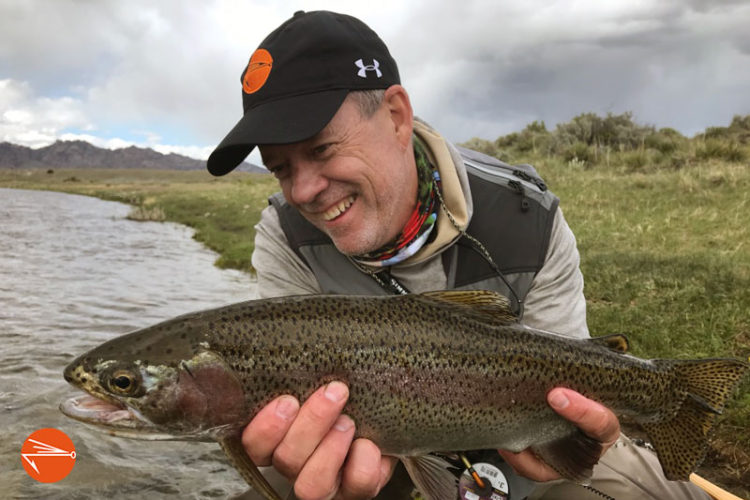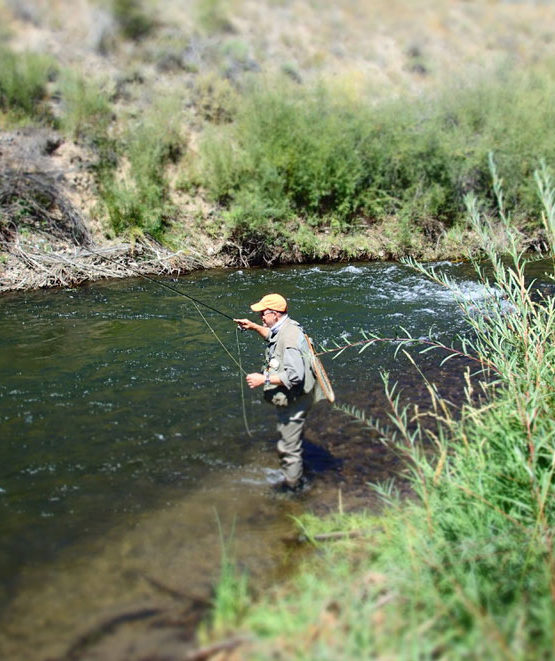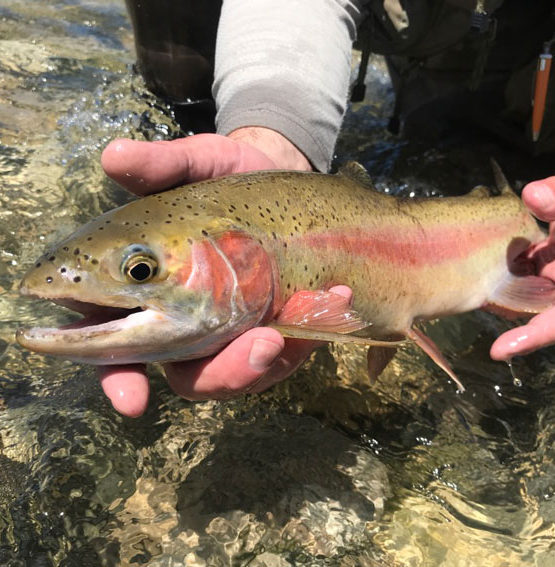Fly fishing fast water is one of the most important skills you can develop as an angler.
However, between the proper technique, focus, and quick reactions, this is one area of fly fishing that takes quite a bit of practice.
That said, if you take the time to learn how to fish fast currents, you’ll be opening the door to some of the best, most exciting fly fishing opportunities you’ll ever experience.
Fortunately, in this post, I’ve compiled 7 of my top tips to help you make the most of any fast water fly fishing situation. Whether it be Spring runoff or just a high-water year, I’m confident that these tips will help you catch more fish.
Let’s wade in!
1. Use More Weight Than You Think You Need
When you are nymphing fast water, you need your nymphs to sink as quickly as possible.
Since your drift won’t last very long, you need those flies to get down to the bottom of the river (where the fish hang out) within the first couple of seconds after hitting the water.
The best way to accomplish that is to add more weight.
And when I say more weight, I’m talking way more weight than you think you need.
If you find that you are getting snagged along the bottom more than usual, you can always remove a weight or two and cast again. But, in most cases, if you don’t get your flies down to the bottom of the river quickly, you probably won’t catch a thing.
As a general rule of thumb, I recommend adding weight until your rig starts “ticking bottom.” In other words, your rig is deep enough to start bumping up against the bottom of the river.
You’ll know you’re ticking bottom if your strike indicator is bobbing up and down slightly throughout your entire drift. Just make sure to set the hook on anything that looks a little stronger than a “tick.”
2. Learn And Use The Tuck Cast
Along with the additional weight, when you’re fly fishing fast water, one of the best techniques you can use is called the Tuck Cast.
The Tuck Cast is a casting technique that causes your rig to hit the water before the rest of your line, and thus, allows it to start sinking before the current starts pulling your line downstream.
To accomplish the Tuck Cast, you basically have 2 options:
- The Overcast Method: With the overcast method, you basically cast your rod with a little more force than necessary so that your line fully extends above the water, and your rig bounces back toward you. When your rig bounces back, it will naturally drop below the rest of your line and end up hitting the water first.
- The “Lift The Tip” Method: With this method, you basically just lift the tip of your rod at the end of your casting motion in order to raise your line up above your rig. This will allow your rig to drop below the rest of your line and hit the water first.
3. Use The “High-Stick” Method
The High-Stick method is a great technique to use if you’re fishing small, fast streams, or you need to manage your line through tricky current.
The best part is, it’s incredibly easy and straightforward.
All you have to do is lift your rod up high in the air after casting in order to keep as much of your line off the water as possible. This will help to reduce the chance of the fast currents messing up your drift and keep your flies floating as naturally as possible.
Another great benefit to using the high stick method is being able to properly identify a strike when you get one.
By keeping the line off of the water and avoiding any other potential confusion from currents, you will be able to more easily recognize a strike when you do finally get one.
To put it simply, the high-stick method eliminates a lot of the variables that come with fly fishing fast water and increases your chances of catching more fish.
4. Don’t Get In Too Deep
I hope this goes without saying, but whenever you’re fly fishing fast water, be mindful of your steps and wade carefully.
Faster currents can be a lot trickier to navigate and potentially dangerous while wading, so make sure that you maintain a healthy respect for the current.
Again, be sure of every step you take so that you do not fall or take a tumble.
While it might be tempting to venture out and find the best fishing holes, you should always fish fast water with caution.
5. Find A Soft Landing Zone
A “landing zone” is the area you plan to net a fish after you have hooked it. And the calmer the landing zone, the easier it is to land a fish.
With that in mind, in faster water, try finding a softer landing zone where you can fight and net your fish.
I realize this may not always be possible, but pulling the fish you hook into softer water will make them much easier to net. It will also reduce your chances of losing the fish, or worse, losing your rig in the rougher water.
Even if you have to walk your fish downstream a little ways, finding a soft landing zone can make your life a lot easier.
6. Walk A Fish Downstream When Possible
If you can’t find a soft landing zone to net your fish, there are a few other things you can do to increase your likelihood of landing a hooked fish. One of these is to walk the fish downstream to avoid fighting the current.
By doing this, you are allowing the fish to properly run (and exhaust itself) without putting too much unnecessary tension on your fishing line.
Just be sure to keep your line tension consistent. And, once again, wade carefully so that you don’t lose your fitting, your fish, and your sanity in one fell swoop.
7. Properly Manage Your Line
Whenever you’re fly fishing fast water, try to keep all of your fly line above your actual flies during the drift by mending it upstream halfway through your drift.
This will keep your fly line from getting caught in the current and pulling your rig, unnaturally through the water.
Since fast water means fast drifts, it’s critical that you keep your flies floating as naturally as possible. And learning how to properly manage your line through your drift is the best way to do that.
Want to improve your fly fishing skills and catch more fish? Be sure to check out some of our other helpful guides:
- 25 Proven Tips To Catch More Trout
- 10 Fly Fishing Accessories Every Angler Should Own
- 7 Fly Casting Techniques Every Angler Should Learn
- 10 Expert Ways To Find Fly Fishing Spots
- 9 Expert Tips To Avoid Fly Fishing Tangles
- Is Fly Fishing Hard? 7 Things You’ll Need To Learn
Final Thoughts
Learning to fly fish fast water will open up tons of opportunities for you as an angler.
And if you take the time to learn these 7 tips, I’m confident you will catch a bunch of fish in the process.
So, be sure to give them a try the next time you hit the water.
Oh, and if you have any other awesome tips for fly fishing fast water, be sure to drop them in the comments below.
Disclaimer: This post may contain affiliate links, meaning we will receive a small commission (at no cost to you) if you click through and make a purchase.









